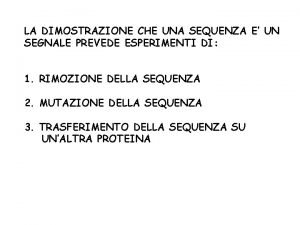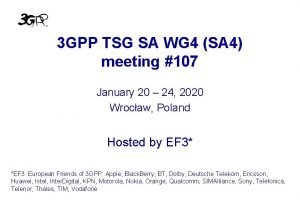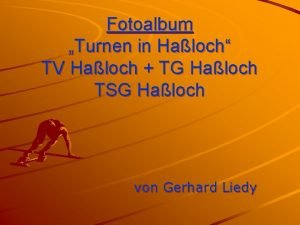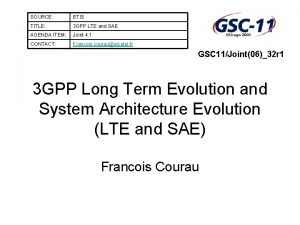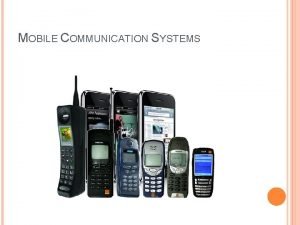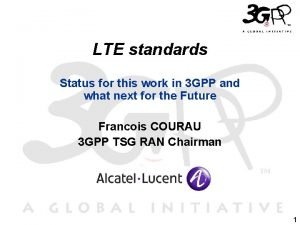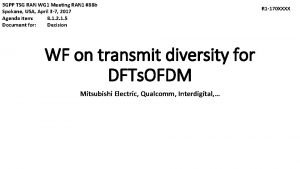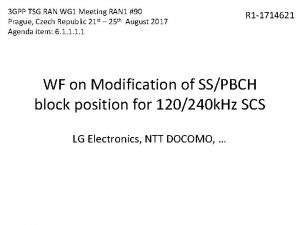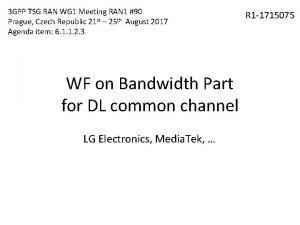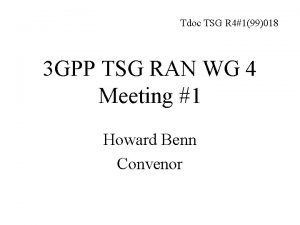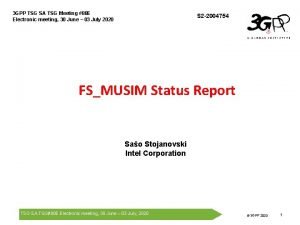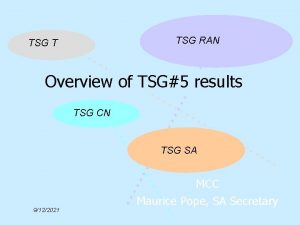3 GPP TSG RAN WG 1 Meeting 92





![Appendix: Use Cases for Specific Scaling Factors (1/2) Table from [1] SCS (k. Hz) Appendix: Use Cases for Specific Scaling Factors (1/2) Table from [1] SCS (k. Hz)](https://slidetodoc.com/presentation_image_h/e03d907da033963242e866e4af6f364a/image-6.jpg)

- Slides: 7

3 GPP TSG RAN WG 1 Meeting #92 Athens, Greece, February 26 ~ March 02, 2018 Agenda 7. 1. 3. 3. 1 R 1 -183485 Approximate Peak Data Rate and Scaling Factor Use Cases Intel

Background (1/2) • Approximate Data Rate:

Background (2/2) • RAN 2 LS R 1 -18013424 ask for the following: – RAN 2 would like to understand the background and the potential scenarios where the UE reports the down scaled value (0. 75) per band combination

Proposed General Use Cases • Use case explicitly discussed in RAN 1 #91 – UE supporting 256 QAM, but is to only reach 64 QAM peak data rate for a particular #MIMO layer and #CC. • Another Use cases identified – UE sharing hardware resource between LTE and NR in EN-DC scenario. • UE in NR SA in FR 2 is able to reach 2 Gbps, but in EN-DC with additional LTE link in FR 1 and due to sharing of the hardware resources, it is only able to support less than 2 Gbps. • RF capability of FR 2 and FR 1 might be completely separate, so supporting additional LTE CC in FR 1 is possible without reducing #CC in FR 2 from RF perspective.

Proposed Changes to Approx. Data Rate • To better address the use cases, and concerns from signaling overhead (from per band combination signaling) the following changes are proposed: • f(j) is the scaling factor: – The DL scaling factor can at least take are the values {1, 0. 8, and 0. 75, 0. 5} – The UL scaling factor are the values {1, 0. 75, 0. 5, TBD} – f(j) is signalled per CC and per BPCband per band combination as per UE capability signalling.
![Appendix Use Cases for Specific Scaling Factors 12 Table from 1 SCS k Hz Appendix: Use Cases for Specific Scaling Factors (1/2) Table from [1] SCS (k. Hz)](https://slidetodoc.com/presentation_image_h/e03d907da033963242e866e4af6f364a/image-6.jpg)
Appendix: Use Cases for Specific Scaling Factors (1/2) Table from [1] SCS (k. Hz) BPC Maximum CBW (MHz) Maximum number of modulation Layers order Real Maximum data rate Calculated with Scaling maximum factor values from BPC and band combination N/A 100 4 8 N/A N/A CA_1 CC 1 30 100 4 8 R 1 1 CA_2 CC 1 30 100 2 8 R 1 2*R 1 0. 5 CC 2 30 100 2 8 CC 1 30 100 4 6 3/4*2*R 1 0. 75 CC 3 30 100 4 6 CA_3 [1] R 1 -1801352, “Discussion on NR UE peak data rate, ” Huawei, Hi. Silicon

Appendix: Use Cases for Specific Scaling Factors (2/2) Assume UE is able to support Max 2 Gbps in baseband In NR SA, NR FR # DL/UL 2 DL SCS BW 60 k. Hz 50 MHz NRB #Layer Mod #CC SF Ts OH Approx. Data Rate 66 2 6 4 1. 0 1. 79 e-5 0. 18 1. 616 Gbps In EN-DC, LTE+NR, LTE FR # #CC BW Mod SCS [k. Hz] #Layer T_SF 1 2 20 8 15 4 0. 001 NR FR # DL/UL Not possible 2 DL Target with SF 2 2 SCS BW Max TBS- Max TBSL 1 L 2 97896 195816 Peak Rate 0. 783 Gbps NRB #Layer Mod #CC SF Ts OH Approx. Data Rate Sum of LTE+NR 60 k. Hz 50 MHz 66 2 6 4 1. 0 1. 79 e-5 0. 18 1. 61 Gbps 2. 39 Gbps DL 60 k. Hz 50 MHz 66 2 6 4 0. 8 1. 79 e-5 0. 18 1. 29 Gbps 2. 07 Gbps DL 60 k. Hz 50 MHz 66 2 6 4 0. 75 1. 79 e-5 0. 18 1. 21 Gbps 1. 99 Gbps
